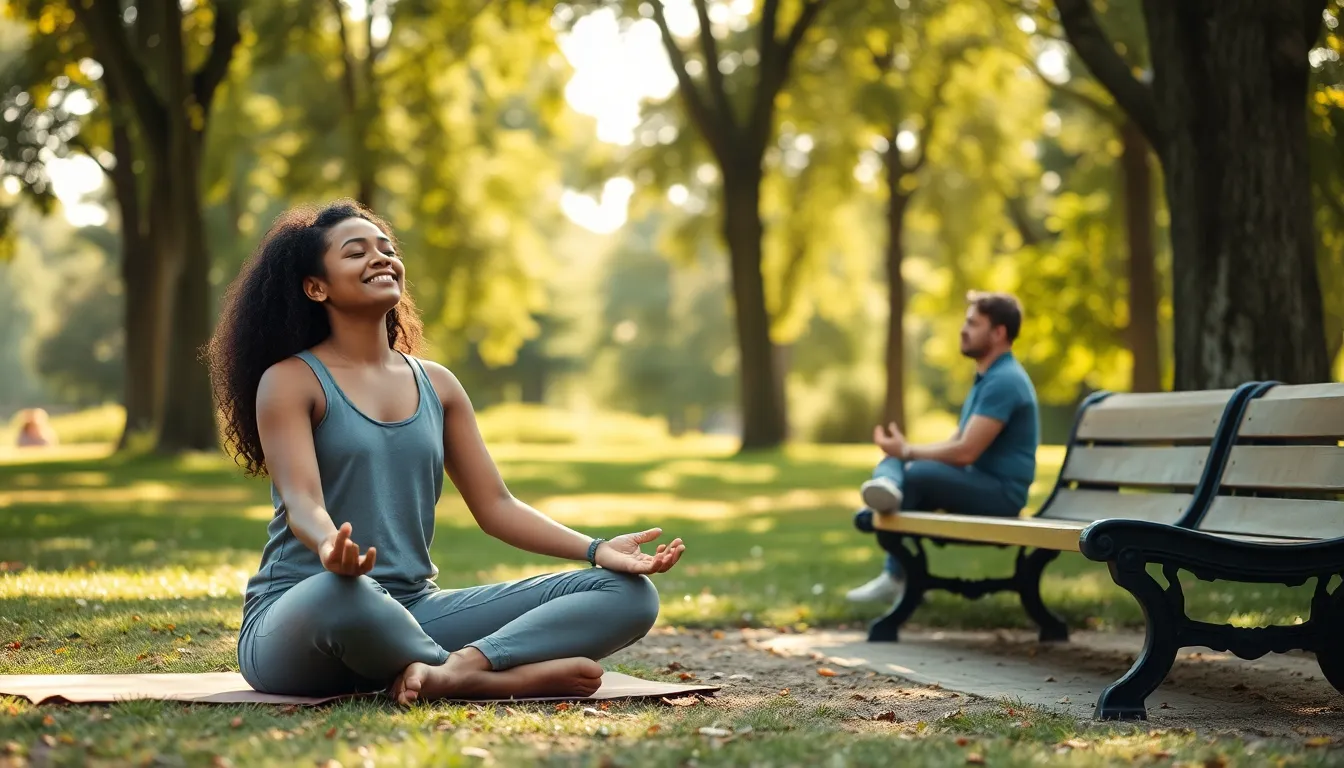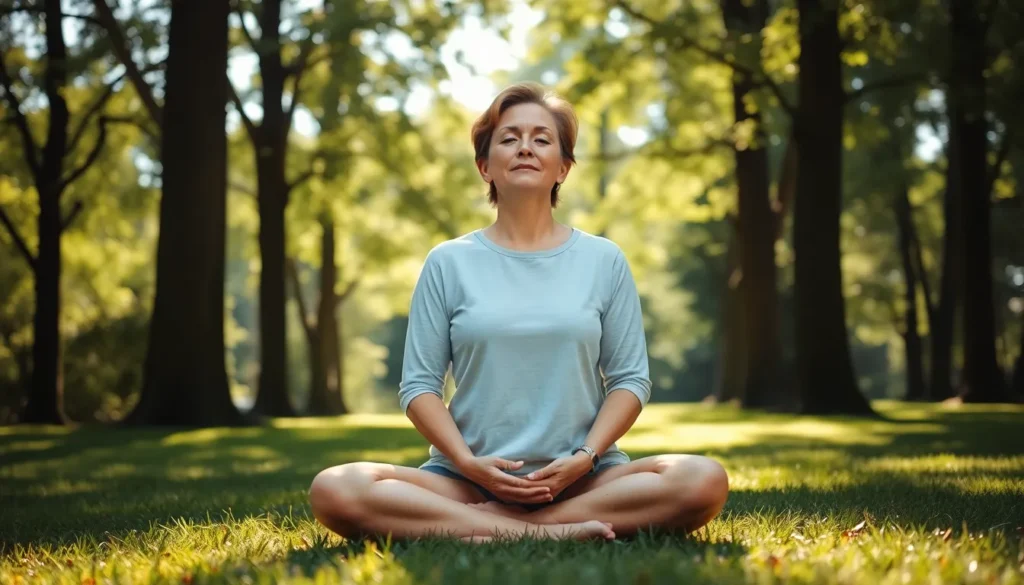In a world buzzing with distractions, finding a moment of peace can feel like searching for a unicorn in a haystack. Yet, mindfulness practices offer a magical solution to help anyone reclaim their sanity. Whether it’s a busy professional drowning in deadlines or a parent juggling a thousand tasks, these practices are the secret sauce to a calmer, more focused life.
Table of Contents
ToggleOverview of Mindfulness Practices
Mindfulness practices encompass various techniques aimed at promoting awareness and presence. These methods help individuals engage with their thoughts and environment without judgment. Techniques often include meditation, breathing exercises, and mindful movement.
Meditation serves as a foundational practice. Individuals focus on their breath or a specific thought to foster clarity and relaxation. Guided meditations further assist practitioners by providing direction through audio cues.
Breathing exercises enhance awareness of the present moment. Deep breathing reduces stress and can be practiced anywhere. Techniques like the 4-7-8 method involve inhaling for four seconds, holding for seven, and exhaling for eight.
Mindful movement integrates physical activity with awareness. Yoga and tai chi exemplify this approach, combining breath with flowing movements. These practices promote both mental and physical well-being.
Practicing gratitude plays a significant role in mindfulness. Noting specific things a person appreciates fosters a positive outlook and enhances emotional resilience. Journaling daily thoughts can solidify this practice.
Body scan meditation encourages a heightened sense of physical awareness. Participants focus attention on various body parts, observing sensations without judgment. This technique aids in recognizing stress locations and promoting relaxation.
Engaging in nature provides another layer to mindfulness. Spending time outdoors can enhance mental clarity and emotional balance. Nature walks or simple observation of surroundings cultivate a deeper connection with the environment.
Individuals can incorporate mindfulness practices into daily routines. Start with just a few minutes each day. Gradually increasing practice leads to significant mental health benefits over time.
Benefits of Mindfulness Practices

Mindfulness practices offer extensive benefits across physical and mental health. They foster overall well-being and contribute to a balanced lifestyle.
Physical Health Benefits
Enhanced heart health represents one significant advantage of mindfulness practices. Studies reveal that mindfulness meditation can lower blood pressure and improve circulation. Reduced inflammation results from consistent mindfulness, potentially lowering risks for chronic diseases. Improved immune function occurs through stress reduction and emotional regulation. Reports indicate that individuals practicing mindfulness regularly often experience fewer physical ailments. Better sleep quality can also result from these practices, leading to increased daytime energy levels.
Mental Health Benefits
Mindfulness practices greatly impact mental health by easing symptoms of anxiety and depression. Individuals who engage in mindfulness techniques experience heightened emotional resilience and greater self-awareness. Research has shown these techniques can decrease rumination and promote a positive mood. Attention spans improve significantly through regular mindfulness practice, allowing for increased focus and productivity. Improved stress management arises from heightened awareness, enabling individuals to navigate challenges more effectively. Regular practitioners often report a stronger sense of well-being and happiness.
Examples of Mindfulness Practices
Mindfulness practices encompass various techniques that promote awareness and presence. Each method offers unique benefits suitable for different individuals.
Meditation Techniques
Various meditation techniques enhance focus and calm. Mindfulness meditation involves paying attention to thoughts without judgment. Guided meditation provides direction through audio or scripts, delivering mental clarity. Loving-kindness meditation fosters compassion toward oneself and others. Transcendental meditation uses a mantra for deep relaxation. Each technique offers distinct advantages, contributing to overall mental well-being.
Breathing Exercises
Breathing exercises encourage immediate relaxation and focus. The 4-7-8 method involves inhaling for four counts, holding breath for seven counts, and exhaling for eight counts. This exercise reduces anxiety and promotes tranquility. Box breathing consists of inhaling, holding, exhaling, and pausing for equal counts, helping to relieve stress. Alternate nostril breathing balances energy and soothes the mind. Each technique improves present-moment awareness and emotional control.
Body Scan
The body scan technique focuses attention on different body parts to cultivate awareness. Start at the head, then progressively scan down to the toes. Individuals notice sensations, tension, or relaxation as they go. This practice enhances body awareness and promotes relaxation. Many use this technique to reduce stress and create a deeper connection with the body. Regular practice improves overall mental well-being.
Mindful Eating
Mindful eating transforms meal experiences by enhancing awareness of food. This practice encourages individuals to savor flavors, textures, and aromas while eating. Slowing down during meals fosters greater appreciation for nourishment. Listening to hunger and fullness cues becomes easier with mindful eating. This approach promotes healthier eating habits and reduces overeating by encouraging conscious choices. Practicing mindfulness during meals boosts overall health.
Yoga and Movement
Yoga and mindful movement integrate physical activity with awareness. Different yoga styles, such as Hatha or Vinyasa, emphasize breath and posture. Practitioners focus on aligning movement with breath, creating a mindful experience. Tai Chi emphasizes slow, flowing movements that enhance balance and focus. Each practice encourages physical and mental benefits, making them suitable for various fitness levels. Committing to regular mindful movement improves overall well-being.
Integrating Mindfulness into Daily Life
Incorporating mindfulness practices into daily routines enhances overall well-being. Start with short meditation sessions, dedicating five to ten minutes each morning. Focus on breathing to anchor awareness and clear the mind. Gradually increase session lengths as comfort grows.
Breathing exercises offer immediate benefits. The 4-7-8 method calms the nervous system, while box breathing creates a sense of stability. Alternate nostril breathing balances energy, encouraging relaxation. Engaging in these practices during breaks promotes moment-to-moment awareness.
Mindful eating transforms mealtime experiences. Focus on each bite and savor flavors, which fosters a healthier relationship with food. Consider using smaller plates to control portion sizes and enhance mindfulness during meals. Engaging senses creates appreciation for nourishment, contributing to weight management.
Physical activities can merge seamlessly with mindfulness. Practices like yoga and tai chi integrate movement with awareness, cultivating both physical strength and mental clarity. Attending classes or following online sessions can strengthen consistency.
Mindfulness moments can appear throughout the day. While commuting, practice being present instead of distracted. Notice surroundings, sounds, and smells to ground oneself in the moment. When chatting with others, fully listen to conversations without multitasking.
Journaling serves as a tool for reflection. Documenting thoughts and emotions enhances self-awareness and provides insight into personal patterns. Set aside time each evening to summarize experiences or express gratitude, fostering positivity.
Integrating mindfulness needs clarity and commitment. A structured approach can make these practices a regular part of life. The benefits will reflect in both mental and physical health, resulting in increased resilience and emotional balance.
Mindfulness practices offer a pathway to greater peace and focus in today’s hectic world. By embracing techniques like meditation and breathing exercises, individuals can cultivate a deeper awareness of their thoughts and surroundings. Incorporating mindful movement through yoga or tai chi further enhances both physical and mental health.
As these practices become part of daily routines, they can lead to significant improvements in emotional resilience and overall well-being. Starting with just a few minutes each day allows anyone to gradually experience the profound benefits of mindfulness. With commitment and consistency, it’s possible to transform one’s quality of life and foster a lasting sense of calm amidst daily distractions.

